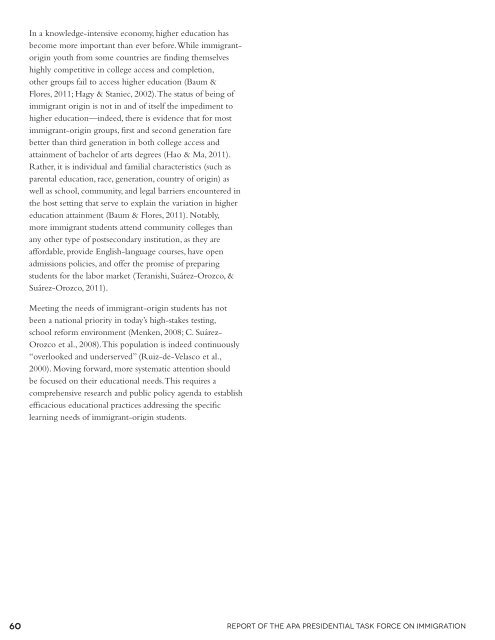Crossroads: The Psychology of Immigration in the New Century
Crossroads: The Psychology of Immigration in the New Century
Crossroads: The Psychology of Immigration in the New Century
Create successful ePaper yourself
Turn your PDF publications into a flip-book with our unique Google optimized e-Paper software.
In a knowledge-<strong>in</strong>tensive economy, higher education has<br />
become more important than ever before. While immigrantorig<strong>in</strong><br />
youth from some countries are f<strong>in</strong>d<strong>in</strong>g <strong>the</strong>mselves<br />
highly competitive <strong>in</strong> college access and completion,<br />
o<strong>the</strong>r groups fail to access higher education (Baum &<br />
Flores, 2011; Hagy & Staniec, 2002). <strong>The</strong> status <strong>of</strong> be<strong>in</strong>g <strong>of</strong><br />
immigrant orig<strong>in</strong> is not <strong>in</strong> and <strong>of</strong> itself <strong>the</strong> impediment to<br />
higher education—<strong>in</strong>deed, <strong>the</strong>re is evidence that for most<br />
immigrant-orig<strong>in</strong> groups, first and second generation fare<br />
better than third generation <strong>in</strong> both college access and<br />
atta<strong>in</strong>ment <strong>of</strong> bachelor <strong>of</strong> arts degrees (Hao & Ma, 2011).<br />
Ra<strong>the</strong>r, it is <strong>in</strong>dividual and familial characteristics (such as<br />
parental education, race, generation, country <strong>of</strong> orig<strong>in</strong>) as<br />
well as school, community, and legal barriers encountered <strong>in</strong><br />
<strong>the</strong> host sett<strong>in</strong>g that serve to expla<strong>in</strong> <strong>the</strong> variation <strong>in</strong> higher<br />
education atta<strong>in</strong>ment (Baum & Flores, 2011). Notably,<br />
more immigrant students attend community colleges than<br />
any o<strong>the</strong>r type <strong>of</strong> postsecondary <strong>in</strong>stitution, as <strong>the</strong>y are<br />
affordable, provide English-language courses, have open<br />
admissions policies, and <strong>of</strong>fer <strong>the</strong> promise <strong>of</strong> prepar<strong>in</strong>g<br />
students for <strong>the</strong> labor market (Teranishi, Suárez-Orozco, &<br />
Suárez-Orozco, 2011).<br />
Meet<strong>in</strong>g <strong>the</strong> needs <strong>of</strong> immigrant-orig<strong>in</strong> students has not<br />
been a national priority <strong>in</strong> today’s high-stakes test<strong>in</strong>g,<br />
school reform environment (Menken, 2008; C. Suárez-<br />
Orozco et al., 2008). This population is <strong>in</strong>deed cont<strong>in</strong>uously<br />
“overlooked and underserved” (Ruiz-de-Velasco et al.,<br />
2000). Mov<strong>in</strong>g forward, more systematic attention should<br />
be focused on <strong>the</strong>ir educational needs. This requires a<br />
comprehensive research and public policy agenda to establish<br />
efficacious educational practices address<strong>in</strong>g <strong>the</strong> specific<br />
learn<strong>in</strong>g needs <strong>of</strong> immigrant-orig<strong>in</strong> students.<br />
60 Report <strong>of</strong> <strong>the</strong> APA Presidential Task Force on <strong>Immigration</strong>
















